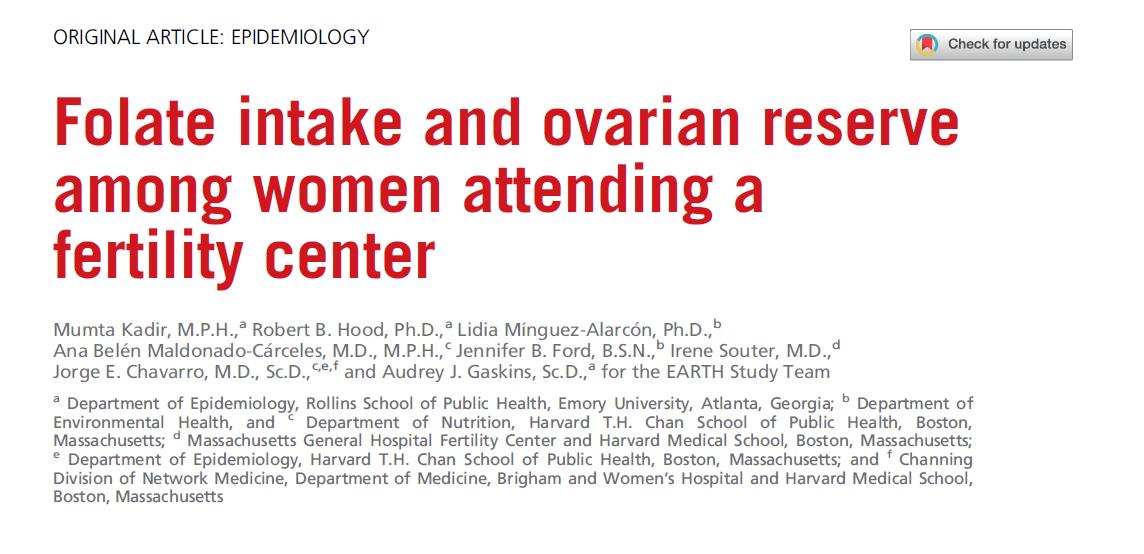For women preparing for pregnancy, ovarian health is the cornerstone of successful conception.
Folic acid, as a "standard nutrient" for pre-pregnancy care, is well-known for its importance in preventing birth defects, reducing the risk of congenital heart disease, and neural tube defects. However, a study published in November 2021 in the authoritative reproductive medicine journal Fertility and Sterility has provided new insights into the relationship between folic acid and ovarian reserve.

Research Findings: A Plateau Effect Exists
This study analyzed data from 552 women who visited the Massachusetts General Hospital Fertility Center in the United States, focusing on the association between folic acid intake and ovarian reserve function (measured by Antral Follicle Count, AFC).

The research revealed an interesting phenomenon: there is a clear dose-response relationship between folic acid intake and ovarian reserve, but this relationship is not linear; instead, it exhibits a plateau effect.
The data indicated that the positive correlation between total folic acid intake and AFC reaches a plateau at approximately 1200 micrograms per day. The peak benefit for folic acid intake from supplements (Folic acid, synthetic folic acid) occurs at about 800 micrograms per day. Compared to women with a daily intake of 400 micrograms of folic acid, those consuming 800 micrograms per day are expected to have an increase of approximately 1.5 follicles.
The study also found that once intake exceeds these levels, higher folic acid consumption does not provide additional benefits. This suggests that while folic acid is important for follicles, supplementation should focus on "precision" rather than "quantity."
How Does Folic Acid "Protect" Follicles?
The active form of folic acid in the body (5-methyltetrahydrofolate) is a key cofactor in the metabolism of homocysteine (Hcy).

When folic acid is insufficient, Hcy cannot be efficiently converted into beneficial methionine, leading to its accumulation in the blood. This results in hyperhomocysteinemia (HHcy), which can affect ovarian health, induce oxidative stress and inflammation, and disrupt the microenvironment required for follicular development.
Simultaneously, folic acid deficiency can impair normal methylation processes, affecting the genetic stability and developmental potential of oocytes.
Therefore, maintaining adequate folic acid levels helps create a more stable and favorable internal environment for follicular development.
Individual Differences: Why Are Some People Less Responsive to Folic Acid Supplementation?
Studies show that approximately 78.4% of the Chinese population has varying degrees of folic acid metabolic impairment, with folic acid metabolic capacity only 30-70% that of individuals with normal metabolism.
|
MTHFR Genotype |
Enzyme Activity |
Folic Acid Utilization Capacity |
Proportion in Chinese Han Population |
Risk of Hyperhomocysteinemia |
|
CC |
Normal (100%) |
Strong |
21.6% |
Low |
|
CT |
Intermediate (65%) |
Moderate |
48.6% |
Medium |
|
TT |
Low (35%) |
Poor |
29.8% |
High |
Geographical Distribution of MTHFR C677T, A1298C and MTRR A66G Gene Polymorphisms in China: Findings from 15357 Adults of Han Nationality. PLOS ONE.

For women preparing for pregnancy who have folic acid metabolism disorders, active folate (such as Magnafolate, [6S]-5-methyltetrahydrofolate calcium) is a more efficient choice.
Compared to ordinary synthetic folic acid (Folic acid), active folate (such as Magnafolate) is not limited by folate metabolism genes. It can be directly absorbed by the body, rapidly increasing serum folate and red blood cell folate levels. It participates in the methionine cycle to reduce Hcy levels in the body, providing better folate supplementation.
References
[1] Kadir, M. (2021). Folate Intake and Ovarian Reserve Among Women Attending a Fertility Center [Doctoral dissertation, Emory University]. Emory Theses and Dissertations. [2] Bailey, S. W., & Ayling, J. E. (2018). The pharmacokinetic advantage of 5-methyltetrahydrofolate for minimization of the risk for birth defects. Scientific Reports, 8, 4096. [3] Lian, Z., Liu, K., Gu, J., et al. (2022). Biological characteristics and applications of folic acid and 5-methyltetrahydrofolate. China Food Additives, (2).
This article is for informational purposes only and does not substitute professional medical advice. Please consult a healthcare provider for personalized guidance.

 Español
Español Português
Português  русский
русский  Français
Français  日本語
日本語  Deutsch
Deutsch  tiếng Việt
tiếng Việt  Italiano
Italiano  Nederlands
Nederlands  ภาษาไทย
ภาษาไทย  Polski
Polski  한국어
한국어  Svenska
Svenska  magyar
magyar  Malay
Malay  বাংলা ভাষার
বাংলা ভাষার  Dansk
Dansk  Suomi
Suomi  हिन्दी
हिन्दी  Pilipino
Pilipino  Türkçe
Türkçe  Gaeilge
Gaeilge  العربية
العربية  Indonesia
Indonesia  Norsk
Norsk  تمل
تمل  český
český  ελληνικά
ελληνικά  український
український  Javanese
Javanese  فارسی
فارسی  தமிழ்
தமிழ்  తెలుగు
తెలుగు  नेपाली
नेपाली  Burmese
Burmese  български
български  ລາວ
ລາວ  Latine
Latine  Қазақша
Қазақша  Euskal
Euskal  Azərbaycan
Azərbaycan  Slovenský jazyk
Slovenský jazyk  Македонски
Македонски  Lietuvos
Lietuvos  Eesti Keel
Eesti Keel  Română
Română  Slovenski
Slovenski  मराठी
मराठी  Srpski језик
Srpski језик 








 Online Service
Online Service